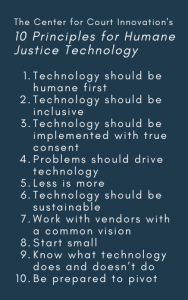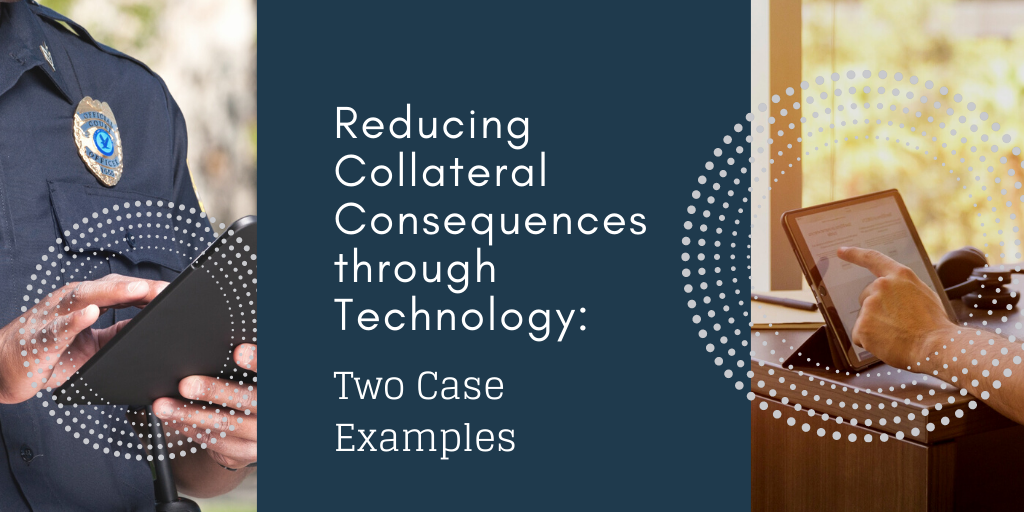 Although they have been around for years, technologies such as virtual reporting, teleservices, and smartphone apps have had a slow uptake in the criminal justice system. Reasons for this include concerns about fairness in the courtroom, mental health information privacy, equitable access to technology, or cost-effectiveness. However, the COVID-19 pandemic has challenged many agencies across the country to begin embracing the use of technology to improve services in the criminal justice system. For those who are still unsure, we look to early adopters to provide guidance on how more local systems can begin incorporating technologies that advance the goals of justice.
Although they have been around for years, technologies such as virtual reporting, teleservices, and smartphone apps have had a slow uptake in the criminal justice system. Reasons for this include concerns about fairness in the courtroom, mental health information privacy, equitable access to technology, or cost-effectiveness. However, the COVID-19 pandemic has challenged many agencies across the country to begin embracing the use of technology to improve services in the criminal justice system. For those who are still unsure, we look to early adopters to provide guidance on how more local systems can begin incorporating technologies that advance the goals of justice.
Some hesitation around the use of technology stems from concerns about infringing on privacy, fostering over-surveillance, or contributing to unanticipated adverse impacts on people involved with the justice system. For consideration of these matters, see the Center for Court Innovation’s 2019 publication 10 Principles for Humane Justice Technology (PDF), which aims to support human dignity and advance best practices around the use of technology. The remainder of this article will use two case examples to focus on how technology is being used to support those with justice involvement.
1. Virtual Mental Health Evaluation and Crisis Response via a Smart App
Grand Lake Mental Health Center in Nowata, Oklahoma, is one of 340 Certified Community Behavioral Health Clinics (CCBHC) operating across 40 states, the District of Columbia, and Guam. Grand Lake has a strong focus on both the quality of care and access to it. When COVID hit and in-person meetings stopped, Grand Lake maintained continuous access to its full range of services. According to Larry Smith, CPRSS, chief executive officer, this continuity of care was made possible by Grand Lake’s partnership with MyCare, a software company that created an iPad app that directly connects individuals to the agency for virtual behavioral health assessments and services. They call their app GrandCare.
Currently, Grand Lake has more than 800 specially equipped iPads in law enforcement vehicles and more than 7,000 in individuals’ homes in the 12 counties it serves. “We created this app specifically for [the people we serve], so they wouldn’t have to come into the clinic,” Smith notes. “We can do services when and where they need us.”
Overall, GrandCare has reduced barriers for individuals and law enforcement officers. Josh Cantwell, LCSW, CPRSS, chief operating officer, says that for individuals, “if the barrier happens to be that they don’t have gas money for transportation, that doesn’t matter because location isn’t a barrier. If they don’t have transportation, period, it doesn’t matter.”
Regarding law enforcement, Smith explains, “If a police officer comes upon someone needing a mental health service, all they have to do is touch a button on that iPad. It would be like having a therapist right there in the front seat with them.” The system is easy to use as well, according to Smith. “Upon installation, the iPad is in single-app mode, [so officers] can’t use it for anything else except for mental health evaluations through our agency,” Smith explains.
Before the use of GrandCare, Cantwell says, police interactions with people in need of mental health services weren’t so simple. Previously, law enforcement had insufficient support in identifying individuals for whom treatment was more appropriate than detention. Even when such cases were clear, the only way for law enforcement to connect individuals in crisis with care was by bringing them to the emergency room for an evaluation, Cantwell elaborated, where lengthy waits could ensue. “So, law enforcement officers were being taken off the street for anywhere from 3 hours to multiple shifts.” Now, using GrandCare, the individual can get assessed remotely while the police officer drives them to one of three 24-hour crisis units Grand Lake operates. In less critical cases, the individual can even be treated on the scene rather than transported. This early evaluation process reduces the likelihood of arrest by identifying individuals that just need treatment, Cantwell points out.
In addition to individuals’ homes and law enforcement vehicles, the specially equipped iPads are in libraries, museums, and other public spaces where a person might present with mental health symptoms that need attention. The goal is to offer services in the least restrictive environment possible. Since using GrandCare, Grand Lake has reduced its inpatient hospitalization rates by 95 percent, Cantwell reports. And no-show appointments are a thing of the past.
Grand Lake staff advocate for the cost-effectiveness of the app and devices. If a person asks, “How can you afford to buy all these iPads and pay for the data plans?” Smith responds saying, “How can you afford not to? All the money we were spending on higher levels of care, we’ve taken and invested into technology and the ability to have an iPad in the client’s home.”
Virtual reporting, also known as teleservices, has had great success in the courts as well—check out the resources below for additional reading.
Video Resources
- GAINS Webinar: The Future of Teleservices in Drug Courts [YouTube]
- GAINS Webinar: Innovations to Support Drug Court Programs during COVID [YouTube]
Resource Materials
2. Virtual Reporting for Individuals on Parole
The Harris County Community Supervision and Corrections Department was an early adopter of virtual reporting, having learned from experience the challenges of maintaining contact with clients amid system-wide closures. Historically, closures were due to natural disasters, such as floods and hurricanes, but when COVID-19 resulted in similar system impacts, the department was ready. Department Director Teresa May, PhD, reports that the legislature had approved the department to do virtual reporting before the pandemic. With approvals in place, the staff was able to “pivot very quickly from people coming into the office to seeing people virtually from anywhere,” May explains.
“A lot of the reasoning for approving virtual reporting was because we’ve been through many hurricanes, where everything shuts down, and you cannot bring people in,” May says. “So, we are familiar with using technology, whether it’s Skype, FaceTime, or Zoom. Those are all mediums we use to connect with people.”
Natural disasters may have been why they started using virtual technology to do parole reporting, but May says her department quickly discovered numerous “silver linings.” First, virtual reporting has helped people who lack reliable transportation, have childcare needs, or cannot take time off from work. Second, after implementing virtual reporting, more than 1,000 individuals under parole supervision have been able to enroll in community college classes due to more scheduling flexibility and less time devoted to commuting to appointments. Finally, according to May, virtual reporting allowed the parole department to continue the mental health and substance use disorder treatment it offers its clients throughout the pandemic.
Knowing that accessing justice via technology doesn’t work unless everyone has the technology, May’s department reached out to the people it supervises to ensure they had everything needed to participate. Luckily, May reports, “the number of people who needed assistance was smaller than anticipated, but it’s still something important we continue to monitor.”
A concern around implementing virtual reporting was a possible increase in absconding but May found the rates did not go up with the use of virtual technology. Despite substantial success with their virtual reporting program, May recognizes it is not for everyone. “We have many high-risk individuals with serious charges that need more face-to-face contact. They need the added structure,” May concludes. Each program needs to incorporate thorough evaluations to make sure they are providing services that meet the needs of the individual and match the delivery method to their context.
Conclusion
The lessons to be drawn from these two examples of using technology in the criminal justice system are broad. Fundamentally, access to technology is an important prerequisite to implementing new technologies in the provision of services across the justice system, but once over that hurdle, there is no one-size-fits-all approach. However, when tailored to local systems and individuals’ needs, incorporating new technologies into agencies’ services can confer many incredible benefits on those agencies, the people they serve, and their communities. Smartphone apps, like GrandCare, can be useful to law enforcement and other community-based services to provide immediate mental health evaluations, connecting individuals with treatment centers, and potentially avoiding their involvement with the criminal justice system altogether. The use of virtual reporting has benefitted Harris County corrections as well as those they serve by reducing the burden of scheduling office visits and allowing flexibility in the lives of those who have been justice involved. This flexibility allows them to take part in the communities to which they’ve returned. It’s as simple, yet transformative, as keeping the job you don’t have to call out on or taking a college class you can reliably be present for. The collateral consequences of justice involvement can be long-lasting, but if these burdens can be reduced by incorporating new technologies, adopting them is an easy choice to make.
Like what you’ve read? Sign up to receive the monthly GAINS eNews!


